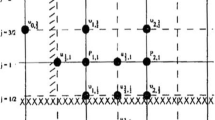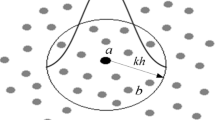Abstract
In this paper, modified volume of fluid method based on flux correct transport (FCT) and Youngs’ VOF (YV) method using new advection method are presented. These methods are from simple line interface construction and piecewise linear interface construction methods. The developed model in this study is based on the Navier–Stokes equations (NSE) which describe the laminar flow of an incompressible viscous fluid. To model turbulence, the coupled Navier–Stokes and standard k−ɛ model as the Reynolds average NSE are used. These equations are discretized using finite difference method on the Cartesian staggered grids and solved using simplified marker and cell method. The free surface is displaced using the volume of fluid method based on FCT and Youngs’ algorithms. In these methods, for staggered grids, fluxes to neighboring cells are estimated based on cell face velocities. It means that fluid particles in the cell have the same velocity of the cell faces. However, in practice, these particles have a variable velocity between velocities of two adjacent cell faces. In the modified models of this research, the velocity in mass center of fluid cell is estimated and used to calculate fluxes from cell faces. The performance of the modified scheme has been evaluated using a number of alternative schemes taking into account translation, rotation; shear test and dam break on dry bed. Finally, Airy waves are generated by these models. The results showed that the modified models are more accurate than the original ones.

Similar content being viewed by others
Abbreviations
- FCT:
-
Flux corrected transport
- FDM:
-
Finite difference method
- MFCT:
-
Modified flux corrected transport
- MYV:
-
Modified Youngs’ VOF
- NSE:
-
Navier–Stokes equations
- NWT:
-
Numerical wave tank
- RANSE:
-
Reynolds average Navier–Stokes equations
- SLIC:
-
Simple line interface calculation
- SMAC:
-
Simplified marker and cell
- SSE:
-
Sum square error
- SAE:
-
Sum absolute error
- PLIC:
-
Piecewise linear interface construction
- TDMA:
-
Three Diagonal Matrix Algorithm
- VOF:
-
Volume of fluid
- F :
-
Colour function
- g i :
-
Source term including acceleration due to gravity in the i direction
- k :
-
Kinetic energy
- p :
-
Dynamic pressure
- Re :
-
Reynolds number
- t :
-
Time
- u :
-
Velocity component in the x direction
- v :
-
Velocity component in the y direction
- ɛ :
-
Dissipation rate
- Δt :
-
Time step
- Δx :
-
Mesh size in the x direction
- Δy :
-
Mesh size in the y direction
References
Burnner B., Tryggavson G.: Direct numerical simulation of three- dimensional bubbly flow. Phys Fluids (Letter) 111, 1967–1969 (1999)
Lafaurie B., Nardone C., Scardovelli R., Zaleski S., Zanetti G.: Modeling merging and fragmentation in multiphase flows with SURFER. J. Comput. Phys. 113, 134–147 (1994)
Noh, W.F.; Woodward, P.: SLIC (Simple line Interface Calculation). In: van Dooren, A.I., Baines, M.J. (eds.) Lecture Notes in Physics, vol. 59, pp. 273–285. Springer, New York (1982)
Nichols, B.D.; Hirt, C.W.; Hotchkiss, R.S.: SOLA-VOF: a solution algorithm for transient fluid flow with multiple free boundaries. Technical Report LA-8355, Los Alamos Scientific Laboratory (1980)
Torrey, M.D.; Cloutman, L.D.; Hirt, C.W.: NASA-VOF2D: a computer program for incompressible flows with free surface. Technical report LA-10462-MS, Los Alamos Scientific Laboratory (1985)
Hirt, C.V.; Nichols, B.D.: Volume of fluid (VOF) method for the dynamics of free boundaries. J. Comput. Phys. 39, 201–225 (1981)
Youngs, D.L.: Time-depend multi- material flow with large fluid distortion. In: Morton, K.W., Baines, M.J. (eds.) Numerical Methods for Fluid dynamics, pp. 273–285. Academic Press, New York (1985)
Rudman M.: Volume-tracking methods for interfacial flow calculations. Int. J. Numer. Methods Fluids 24, 671–691 (1997)
Duff, E.S.: Fluid flows aspects of solidification modeling: simulation of low pressure Die casting. Ph.D. Thesis, University of Queensland, Brisbane (1999)
Rider W.J., Kothe B.D.: Reconstructing volume tracking. J. Comput. Phys. 141, 112–152 (1998)
Harvie D.J.E., Fletcher D.F.: A new volume of fluid advection algorithm: the defined donating region scheme. Int. J. Numer. Methods Fluid 35, 151–172 (2001)
Harvie D.J.E., Fletcher D.F.: A new volume of fluid advection algorithm: the stream scheme. J. Comput. Phys. 162, 1–32 (2000)
Geuyffier D., Li J., Nadim A., Scardovelli R., Zaleski S.: Volume-of-fluid interface tracking with smoothed surface stress methods for three-dimensional flows. J. Comput. Phys. 152, 423–456 (1999)
Scardovelli, R.; Zaleski, S.: NOTE: analytical relations connecting linear interfaces and volume fractions in rectangular grid. J. Comput. Phys. 164, 228–237 (2000)
Scardovelli, R.; Zaleski, S.: Interface reconstruction with least-square fit and split Eulerian– Lagrangian advection. Int. J. Numer. Methods Fluids 41, 251–274 (2003)
Rafei, R.: Numerical solution of incompressible 3D turbulent flow in a spiral channel. M.Sc. thesis, Amirkabir University of Technology, Iran, Tehran (2004)
Li C.W., Zang Y.F.: Simulation of free surface recirculating flows in semi-enclosed water bodies by a k−w model. Appl. Math. Model. 22, 153–164 (1998)
Gao, H.; Gu, H.Y.; Guo, L.J.: Numerical study of stratified oil-water two-phase turbulent flow in a horizontal tube. Int. J. Heat Mass Transfer 46, 749–754 (2003)
Ren B., Wang Y.: Numerical simulation of random wave slamming on structures in the splash zone. Ocean Eng. 31, 547–560 (2004)
Shen, Y.M.; Ng, C.O.; Zheng, Y.H.: Simulation of wave propagation over a submerged bar using the VOF method with a two-equation k−ɛ turbulence modeling. Ocean Eng. 31, 87–95 (2004)
Asadi S., Passandideh-Fard M.: A computational study on droplet impingement onto a thin liquid film. Arab. J. Sci. Eng. 34, 505–517 (2009)
Saghi H., Ketabdari M.J., Zamirian M.: A novel algorithm based on parameterization method for calculation of curvature of the free surface flows. Appl. Math. Model. 37, 570–585 (2013)
Fletcher, C.A.J.: Computational Techniques for Fluid Dynamics, 1st edn. Springer Series in Computational Physics (1988)
Renouard, D.P.; Seabra-Santos, F.J.; Temperville, A.M.: Experimental study of the generation, damping and reflection of a solitary wave. Dyn. Atm. Oceans 9, 341–358 (1985)
Boussinesq M.J.: Théorie de l’intumescence liquide, appelée onde solitaire ou de translation. se propageant dans un canal rectangulaire. C.-R. Acad. Sci. Paris. 72, 755–759 (1871)
Versteeg, H.K.; Malalaskera, W.: An Introduction to Computational Fluid Dynamics, The Finite Volume Method. Longman, Harlow (1995)
Ketabdari, M.J.; Saghi, H.: Large Eddy simulation of laminar and turbulent flow on collocated and staggered grids. ISRN Mech. Eng., vol. 2011, Article ID 809498 (2011). doi:10.5402/2011/809498
Ketabdari, M.J.; Nobari, M.R.H.; Moradi Larmaei, M.: Simulation of waves group propogation and breaking in coastal zone using a Navier–Stokes solver with an improved VOF free surface treatment. Appl. Ocean Res. 30, 130–143 (2008)
Nobari, M.R.H.; Ketabdari, M.J.; Moradi Larmaei, M.: A modified volume of fluid advection method for uniform Cartesian grids. Appl. Math. Model. 33, 2298–2310 (2009)
Zalesak, S.T.: Fully multidimensional flux-corrected transport algorithms for fluids: J. Comput. Phys. 31, 335–362 (1979)
Ghia, U.; Ghia, K.N.; Shin, C.T.: High-re solutions for incompressible flow using the Navier–Stokes Equations and a multigrid method. J. Comput. Phys. 48, 387–411 (1982)
Nakayama, T.; Washizu, K.: Boundary element analysis of nonlinear sloshing problems. In: Bauerjee, P.K., Mukherjee, S. (eds.) Developments in Boundary Element Method-3. Elsevier Applied Science Publishers, Newyork (1984)
Martin, J.C.; Moyce, W.J.: An experimental study of the collapse of liquid columns on a rigid horizontal plane. Philos. Trans. R. Soc. Lond. 244, 312–324 (1952)
Romate, J.E.: Absorbing boundary conditions for free surface waves. Comput. Phys. 99, 135–145 (1992)
Dean, R.G.; Darlymple, R.A.: Water wave mechanics for engineers and scientists. In: Advance Series on Ocean Engineering, vol. 2. World scientific publishing Co., Singapore (1991)
Sorensen, R.M.: Basic coastal engineering, 3rd edn. In: Library of congress cataloging-in-publication data (2000)
Author information
Authors and Affiliations
Corresponding author
Rights and permissions
About this article
Cite this article
Saghi, H., Ketabdari, M.J. A Modification to SLIC and PLIC Volume of Fluid Models using New Advection Method. Arab J Sci Eng 39, 669–684 (2014). https://doi.org/10.1007/s13369-013-0688-9
Received:
Accepted:
Published:
Issue Date:
DOI: https://doi.org/10.1007/s13369-013-0688-9




